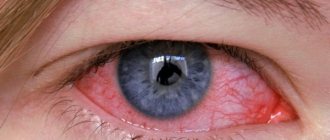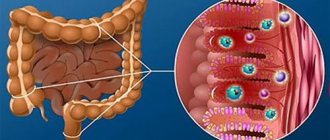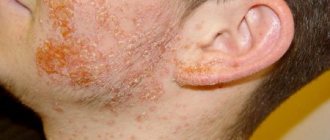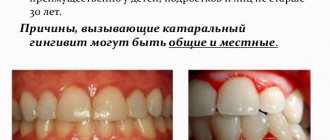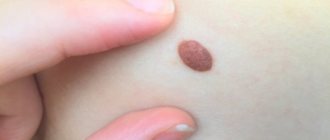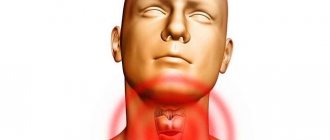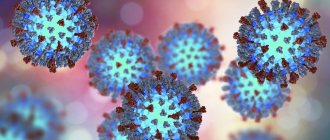general description
Contact allergic dermatitis is an inflammation of the skin that occurs at the site of contact with a particular allergen.
An inflammatory allergic reaction develops in a delayed manner, with prolonged and regular contact of the body with the allergen. During this contact, the patient's body develops increased sensitivity. Clinically, the disease is manifested by redness and swelling of the skin that has been in contact with the allergen, and the appearance of various rashes on it.
Therapy of the disease consists of eliminating any contact of the patient with the allergen. To eliminate hyperemia, itching, swelling of the skin, and rashes, symptomatic treatment is carried out (antihistamines locally and orally; in severe cases, glucocorticosteroids are indicated).
Reasons for appearance
Causes of contact dermatitis:
- hereditary predisposition - occurs if at least one of the parents has ever had allergic reactions;
- stress, nervous tension, which deplete the body’s strength, resulting in a decrease in its protective functions and increased susceptibility to allergens;
- weakened immunity reduces the ability to withstand the aggressive effects of substances from the environment.
In children
Almost every mother is familiar with the manifestation of allergic dermatitis in newborns.
The skin of babies is very delicate and with insufficient hygiene, redness and inflammation often form in the perineal area and folds, causing itching and discomfort. Contact dermatitis in a child can be caused by a disposable diaper due to the presence of fragrances in the composition or due to long wearing.
To prevent negative consequences, it is necessary to wash the child more often and treat the skin with drying powder, baby or medicinal cream.
If treatment is delayed, contact dermatitis in an infant can cause the attachment of an infectious component, so it is necessary to remove the irritant as soon as possible and take care to restore the integrity of the skin.
A variety of substances can cause a reaction on the skin of children: various types of plastic, rubber, synthetic fabrics, wool, and, in the spring and summer, pollen from ubiquitous plants.
The skin at the site of contact with the allergen itches, swells, and bubbles filled with cellular fluid form, which makes children want to scratch the affected areas.
Prolonged exposure to aggressive substances causes severe redness and peeling on the skin of children, the treatment of which is complicated by a chronic inflammatory process in the skin.
If there is any suspicion of dermatitis, you must inform your pediatrician and allergist to prescribe antiallergic drugs. To avoid recurrence of the disease, it is recommended to ensure that children’s food is free of potential allergens.
In adults
When exposed to irritating substances, for example at work, contact dermatitis in adults often occurs as a response from the body.
The use of protective equipment (gloves, hats, glasses, overalls) and water procedures after a hard day helps prevent the occurrence of such reactions.
If control methods are ineffective to get rid of the manifestations of contact dermatitis in adults, it is advisable to consider the possibility of changing activities. Enduring itching and pain every day is not only physically difficult, but also fraught with serious consequences.
In turn, housewives have also heard about such a phenomenon as contact dermatitis on the palms, fingers, wrists and other areas of the skin that come into contact with aggressive household detergents.
Therefore, in order to prevent contact dermatitis on the hands from spoiling their aesthetic appearance, it is worth taking the necessary measures to protect the skin and use a moisturizer.
Classification
Depending on the course of the disease, the following forms of allergic contact dermatitis are distinguished:
- acute - occurs almost immediately after contact with the allergen, the clinical picture is clear, after eliminating the provoking substance, the symptoms disappear and complete recovery occurs, the duration of the acute form of the disease does not exceed six weeks;
- chronic - characterized by a long course, periods of exacerbation of the disease are replaced by remission, when the patient feels normal, the disease lasts more than six weeks.
Causes of allergic contact dermatitis
The main cause of this disease is the abnormal reaction of the patient’s body to various stimuli. In this case, initially the lesion is located at the site of direct contact of the allergen with the body. However, as the disease progresses, the provoking substance accumulates in the body, which can cause the development of an allergic reaction anywhere in the body.
The most common allergens for this type of dermatitis are:
- alloys of various metals (cobalt, nickel, chromium, copper);
- sealants, paints, varnishes and so on;
- clothing (especially underwear) made from synthetic materials;
- rubber and latex;
- plants;
- household chemicals;
- some external medications;
- cosmetics;
- Sun rays.
In some cases, the cause of contact dermatitis is fungi, viruses, and bacteria.
| Mechanism of development of allergic contact dermatitis |
Symptoms
You need to know what contact dermatitis looks like on different parts of the body in order to take measures to combat it.
First of all, it is necessary to find out the cause of skin irritation. It is better to stop contact with the allergen completely or, if possible, reduce it, while observing safety precautions. Often, compliance with just one requirement can significantly reduce the inflammatory process.
Contact dermatitis on the face is characterized by the appearance of areas with inflammatory processes on the skin that itch and blisters form.
Depending on the type of irritant, the onset of the disease can be triggered by various factors:
- contact with household chemicals (soap, shampoo, washing powders, window cleaners);
- aggressive effects of chemicals (alkali, acid);
- industrial products (paints, varnishes, oils);
- temperature (heat, cold);
- solar radiation;
- vegetable (plant fingers, skin contact with herbal juice);
- allergic (irritation after eating foods).
The symptoms of contact dermatitis on different parts of the body differ slightly. It depends on the structure of the skin.
The skin of the hands is often susceptible to disease due to constant exposure to detergents, cleaning substances and other irritants. In this case, inflammation can be localized on the entire surface or in individual areas.
Manifestations of contact dermatitis
Without the use of gloves, dermatitis may appear on the fingers; this occurs due to the action of allergens. Characteristic signs for this pathology: reddened, swollen fingers, blisters with intercellular fluid. Chemicals are the main cause of this disease.
Contact dermatitis of the eyelids is manifested by the appearance of puffiness, swelling, and itching in the eye area. It most often occurs as a reaction to a gel or cream for the skin around the eyes or as a reaction to cosmetics (mascara, eyeliner, eye shadow).
It is necessary to immediately stop using the drugs that caused such a reaction, otherwise the condition may worsen and the eye simply cannot be opened due to severe swelling. Eye dermatitis causes a lot of discomfort and is of an aesthetic nature, so cosmetics should be selected with caution.
Dermatitis on the legs often appears in the summer, when the possibility of an allergic reaction increases due to insect bites, solar activity and other factors. The affected areas on the legs are marked by redness, swelling, and itching.
Symptoms of allergic contact dermatitis
The main clinical signs of the disease are:
- severe skin itching;
- hyperemia and swelling of the skin;
- the appearance of various rashes like urticaria at the site of skin contact with the allergen.
These symptoms can also be observed in a number of other diseases, so before starting treatment, it is necessary to carry out a clear differential diagnosis. Only an allergist should make a diagnosis. Self-medication is unacceptable and can lead to the development of a number of dangerous complications.
In allergic contact dermatitis, all inflamed areas of the skin are uneven and have different sizes. Sometimes foci of inflammation can merge with each other.
| Allergic contact dermatitis: photo | |
If the course of the disease is complicated by the addition of a secondary infection, which enters the lesions during severe scratching of the skin, then the formation of painful purulent blisters is possible. After the inflammation is relieved, yellow-pink crusts form in their place, which soon dry out and fall off.
This type of dermatitis is not contagious, but in the absence of timely treatment and long-term contact of the patient’s body with the allergen, the disease can become chronic, which is difficult to treat.
Chronic allergic dermatitis has a blurred clinical picture. During exacerbations of the disease, patients complain of itching, thickening and redness of the skin.
Treatment of contact allergies
Treatment of contact allergies is carried out only as prescribed by a doctor and under his strict supervision. It is important to know that redness of the skin, itching and other signs of allergies are not always a consequence of this particular disease. Therefore, the use of therapeutic drugs should be postponed until the diagnosis is confirmed. And, first of all, it is necessary to remove the causes of skin irritation.
If you do not remove what causes the allergy, then taking anti-allergy medications is useless. Only after identifying and eliminating the cause of the allergen should you undergo a course of therapy to restore health. However, drugs such as Erius, Claritin and others quickly relieve discomfort and are prescribed by doctors to reduce allergy symptoms.
Diagnostics
The diagnosis is made comprehensively based on anamnesis, questioning and examination of the patient, the clinical picture of the disease and is confirmed by laboratory and instrumental research data.
In order to accurately determine the substance that causes an allergic reaction, special skin patch tests are performed. The essence of this technique is that several sticky paper plates with allergens applied to them are glued to the previously cleansed skin of the back and left for 2 days. Each plate may contain ten or more allergens.
If the patient is allergic to any of the substances on the plate, the skin under this cell becomes inflamed, swollen and red. If there is a sudden reaction, a small blister may appear in this area. After removing the plates, the allergy quickly disappears.
| Allergic dermatitis test |
You can buy such tests yourself at a pharmacy. Their use does not pose a danger to the health and life of the patient. But the results should still be analyzed by a specialist who has experience with such tests.
You can take antihistamines during the tests; they will not affect the accuracy of the results. But you should stop taking glucocorticosteroids (both local and systemic) at least five days before the start of the tests. It should be remembered that any studies related to the application of allergens to the patient’s skin are carried out only during periods of remission of the disease.
Allergens
The following substances most often cause an allergic reaction upon contact:
- Metals that are also found in stainless steel cookware.
- Stabilizers, preservatives. These substances are also present in cosmetics.
- Dinitrochlorobenzene included in hair dye.
- Plants that contain sensitizers. Such as chrysanthemums, tulips and others.
- Natural and synthetic polymers.
- Formalin.
It should be remembered that both polymers and metal alloys are contained in dentures. Therefore, those people who are prone to allergies should pay attention to this aspect when treating an allergic reaction.
Treatment of allergic contact dermatitis
The first and most important step in treating allergies is to eliminate the patient's body from contact with the allergen. Without this, any therapy will be completely ineffective.
If the disease is caused by body jewelry, then it must be removed. If the cause of the allergy is contact with an irritant at the workplace, then ideally you need to change jobs. If this is not possible, then it is necessary to limit as much as possible any contact with the allergen, and also be sure to use personal protective equipment.
If the irritant accidentally gets on the skin, it is necessary to wash it off as quickly as possible under running water and soap, and then wipe the skin dry with a towel. If you are allergic to household chemicals, you must either completely abandon its use or switch to hypoallergenic products.
Drug treatment of the disease includes the use of both local and systemic drugs. Therapy is carried out on an outpatient basis; only in the most severe cases, when most of the skin is affected, treatment is carried out in a specialized dermatological hospital.
In the acute course of the disease, when there is inflammation and weeping of the affected areas of the skin, application of lotions with Burov's liquid is indicated.
| Lotions for the treatment of allergic contact dermatitis |
Corticosteroid ointments provide a good therapeutic effect. Only the attending physician can prescribe these medications. Corticosteroids are applied to the affected skin 1-2 times a day, the course of treatment should not exceed 14 days.
Antihistamines are mandatory to relieve skin itching and reduce swelling. They are usually taken once a day, the course of treatment is 10 days.
If the above treatment regimen does not produce results, the doctor may prescribe systemic corticosteroids.
Causes
When considering the factors that cause a rash on the stomach, it is worth noting the following:
- Premenstrual syndrome in women. Rash on the abdomen may be associated with changes in hormonal levels.
- Infectious skin lesions that are transmitted through contact with sick people. These include all types of lichen.
- Several types of infectious diseases, such as rubella, chicken pox, measles, herpes, scarlet fever.
- Sexually transmitted infections can cause an itchy rash on the abdomen of an adult.
- Simple dermatitis is an acute inflammation of the skin caused by allergens or irritants. The modern name is CD (contact dermatitis).
- Allergy.
- A contagious skin disease caused by the microscopic parasite scabies mite (scabies).
- Hormonal imbalance caused by pregnancy or menopause. This explains stomach allergies during pregnancy.
- Pathological changes in the functioning of the kidneys and endocrine system.
- Wearing uncomfortable clothes. Sometimes irritation appears on the stomach from using a belt.
Allergy to the stomach during pregnancy
If the rash does not itch, then this is not very good. It is possible that serious diseases of internal organs develop in the human body. It is worth noting several reasons that influence the appearance of a rash without itching:
- allergic reaction;
- pregnancy;
- skin disease caused by excessive sweating;
- wen.
Prevention
The main preventive measure for this type of allergy is the complete exclusion of any contact with the allergen.
In order to avoid relapse of the disease, the following recommendations must be followed:
- If possible, avoid items and decorations that can trigger allergies;
- refuse self-medication; any medications should be prescribed only by a doctor after carrying out the necessary diagnostic measures and making a diagnosis;
- it is necessary to use household chemicals to a minimum;
- When working with chemicals and plants, it is necessary to use personal protective equipment;
- use hypoallergenic cosmetics;
- walk more in the fresh air, exercise;
- periodically sanitize foci of chronic infection in the body;
- engage in hardening, strengthen the body’s immune defense;
- Healthy food.
Good health to you!
Differential diagnosis
Contact allergies should be distinguished from simple contact, atopic and seborrheic dermatitis.
Simple contact dermatitis develops when:
- exposure to chemicals on the skin;
- or due to mechanical trauma (friction, compression, thermal effects).
The mechanism of its development is the occurrence of inflammation in response to skin damage without the participation of the immune system.
Moreover, signs of inflammation appear immediately after exposure to an aggressive factor on the skin, and not after some time.
The development of atopic dermatitis can often be traced back to childhood. Noted:
- dry skin;
- skin itching precedes the appearance of rash elements;
- characterized by symmetrical lesions of the flexor surfaces
- the contours of the affected areas are usually unclear.
Seborrheic dermatitis develops against the background of oily skin and is usually localized on the scalp and nasolabial folds.
The affected areas are covered with greasy scales. There is usually no itching with seborrheic dermatitis.
It should also be borne in mind that some drugs, such as hormonal contraceptives, tetracyclines and a number of others, can cause skin damage when exposed to ultraviolet radiation.
Only exposed areas of the skin exposed to insolation are affected. This type of lesion is called photocontact dermatitis.
There are also phototoxic dermatitis, in which the skin is damaged under the influence of substances that acquire their toxicity as a result of ultraviolet radiation.
An example is dermatitis caused by hogweed juice in sunny weather.
